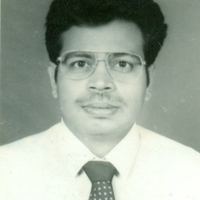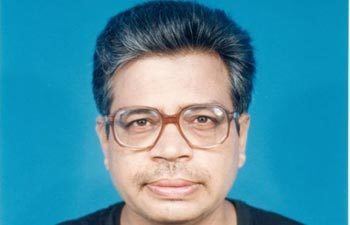Native name আভাস মিত্র Name Abhas Mitra | Role Researcher | |
Born 18 June 1955 (age 70)
India ( 1955-06-18 ) Institutions Bhabha Atomic Research Centre
Homi Bhabha National Institute Alma mater University of Calcutta, University of Mumbai Fields Astrophysics, Theoretical physics, Astronomy Institution Bhabha Atomic Research Centre, Homi Bhabha National Institute Similar People Amal Kumar Raychaudhuri, Anil Kakodkar, Ashoke Sen, Jayant Narlikar, Homi J Bhabha | ||
Abhas mitra guest lecture kshitij 2016 iit kharagpur
Abhas Mitra (born 18 June 1955) is an Indian astrophysicist best known for his distinct views on several front-line astrophysics concepts, particularly related to black holes and Big Bang cosmology involving the black hole information paradox.
Contents
- Abhas mitra guest lecture kshitij 2016 iit kharagpur
- Sorry no interstellar dr abhas mitra tedxxie
- Education and career
- Eternally collapsing objects
- Against the Big Bang paradigm
- Claimed confirmation of his prediction
- Academic associations
- References

Mitra has regularly questioned the mainstream cosmological concepts of the Big Bang and black holes. Scientific diaspora including Richard A. Muller came into his favour of his claim of resolution of black hole information paradox presented 13 years before Stephen Hawking. Richard Muller appreciating the claim of Mitra made, remarking: "I think Mitra resolved the paradox before Hawking, and did it in a way that is superior."

He claims to have offered exact proofs that:
Consequently, dark energy, his research claims, is an illusion caused by the departure of the complex universe from the simple Big Bang model.
Sorry no interstellar dr abhas mitra tedxxie
Education and career
He is an alumnus of the Uttarpara Govt. High School, and the University of Calcutta. He did a part of his PhD work at the University of Kashmir before transferring because of armed insurgency that had erupted in Kashmir. The University of Mumbai conferred upon him the status of a "Distinguished Alumnus".
Eternally collapsing objects
Though Mitra stresses that the black hole solutions are correct, his contention is that black hole masses, arising from relevant integration constants, are actually zero. His peer reviewed paper published in the Journal of Mathematical Physics supports this contention by showing that Schwarzschild black holes have M = 0. If so,
And since the formation of a mathematical zero mass black hole requires infinite proper time, continued gravitational collapse becomes eternal, and the so-called black hole candidates must be Eternally collapsing objects (ECOs).
Mitra's papers describe why continued physical gravitational collapse should lead to formation of ECOs rather than true black holes, and the mathematical "black hole" states can be achieved only asymptotically. An ECO is essentially a quasi-stable ultra-compact ball of plasma which is so hot due to preceding gravitational contraction that its outward radiation pressure balances its inward pull of gravity. Mitra is not alone in this conclusion: Robertson and Leiter (2002) reached a similar conclusion in their introduction of the concept of a magnetospheric eternally collapsing object as an alternative to the black hole model.
In 2014, soon after Stephen Hawking called the alleged loss of information in black holes his "biggest blunder", Mitra received widespread attention in the Indian media, claiming that he had been "vindicated", citing that he had apparently refuted Hawking and indicated the same almost 13 years back.
Against the Big Bang paradigm
As per the present version of Big Bang paradigm, almost 70% of the mass energy of the universe is due to dark energy whose most likely form is Einstein's cosmological constant. Mitra claims that the cosmological constant is exactly zero.
According to Mitra, a Big Bang universe can expand only linearly; therefore, popular inflationary and cyclic models are actually inconsistent.
Since perfect Hubble flow implies radially outward motion of Test particles receding from one another without any mutual collision, he claimed his research showed that ideal Big Bang model corresponds to zero pressure and temperature. If correct, this implies that the ideal Big Bang model is fundamentally unable to describe the physical universe endowed with pressure and temperature.
He has also questioned the physical reality of dark energy.
Claimed confirmation of his prediction
According to Mitra, black holes are actually ultra-magnetized and ultra-hot balls of plasma, nicknamed magnetospheric eternally collapsing objects (MECOs) which are something like extremely general relativistic versions of Sun. He claims, accordingly, MECOs can give rise to flares like solar flares and Coronal mass ejections like the Sun. And on October 25, 2015, NASA reported that its NuStar telescope has detected a massive X-ray flare from a supermassive black hole in a certain quasar, and this flare appears to be triggered by emission of corona from very close to the black hole. In an interview to Nature India, Mitra claimed that, emission of such a corona from the so-called black hole suggests that it is actually a MECO and not a true mathematical black hole. In an international workshop entitled "Jet Triggering Mechanisms in Black Hole Sources", organized by Tata Institute of Fundamental Research, Mumbai, India (January 20–23, 2016), Mitra elaborated on this point in the presence of large number of astrophysicists.
Academic associations
Mitra is associated with the Himalayan Gamma Ray Observatory being set up at Han Leh jointly by Tata Institute of Fundamental Research, Bhabha Atomic Research Centre, and Indian Institute of Astrophysics. He is also an adjunct professor in Homi Bhabha National Science Institute since 2010. Mitra is also a member of the International Astronomical Union.
